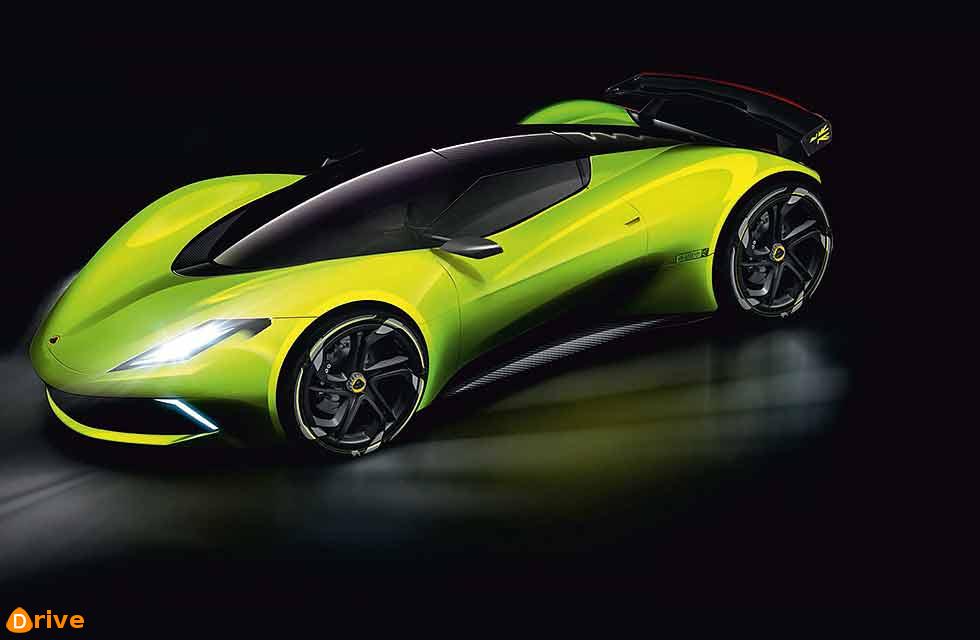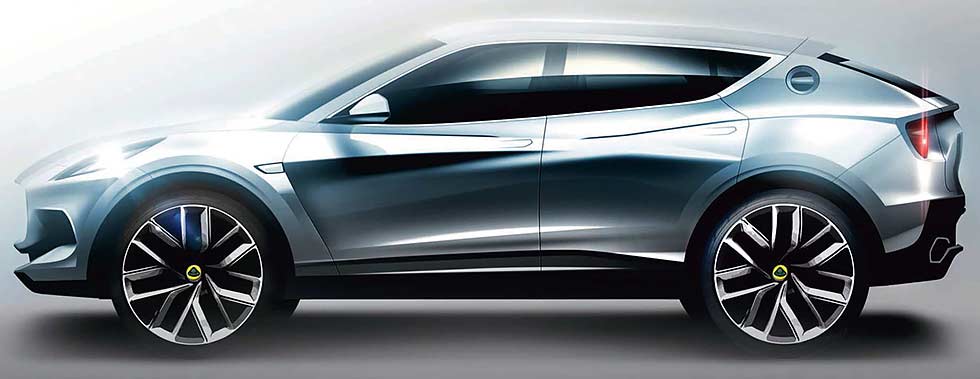Secret Omega project under way to create Bugatti-baiting EV; concept due in 2019.
Lotus is set to stun the world with a new £2 million-plus electric hypercar that acts as a statement of intent under new owner Geely. The new model will be built in strictly limited numbers, and will be the fastest, most expensive and most radical model made by Lotus in its 70-year history.
Lotus Reborn! Shock new Lotus, Bugatti Chiron rival plus new Evora and SUV

The project is shrouded in secrecy at Lotus’s Hethel headquarters in Norfolk, but Drive-My understands it has been given the codename Omega and development work is well under way, with a reveal of a concept version set for next year.
Further details are scarce at this stage, but Drive-My can confirm the new model will use a bespoke all-electric drivetrain when it launches early in the next decade. The £2m-plus price tag will propel Lotus into a rarefied league it has never gone near before; the firm has only recently started selling some variants of its models for more than £100,000, including the Exige and 3-Eleven.
But while every Lotus since the Esprit has been a sports car rather than a supercar, the Omega project will see Lotus jump straight into the world of hypercar making. The model will be priced far in excess of the likes of previous electrified hypercars including the 2017 McLaren P1, LaFerrari and 2015 Porsche 918 Spyder, and close to the £2.5m 2018 Bugatti Chiron.

Lotus senses an opportunity with electric technology to reposition itself as the most cutting-edge of performance car makers. Its new majority shareholder, Geely, is keen to leverage Lotus as the halo brand for both technology and performance in its group, which also includes Volvo, Polestar, Lynk & Co, taxi maker LEVC, Proton and flying car maker Terrafugia.
Lotus has made its name creating lightweight models, so the adoption of electric power will pose a challenge to the Hethel engineers given the added weight of the batteries powering the electric motors. To back up its price tag, Lotus will need some hefty headline numbers from its new hypercar – 1000bhpplus is touted as one target – alongside some innovative, ground-breaking technology, through not only electric motors but possibly also next-generation battery technology to improve power density and reduce the amount of cells needed. This would help keep the car’s kerb weight within the realms of the “simplify, then add lightness” philosophy embedded by Lotus founder Colin Chapman.
All-wheel drive through multiple electric motors will surely be a necessity to help get the Omega’s considerable power and torque reserves to the road in an effective manner. As with most EVs coming now, a range of more than 250 miles will be needed, as will fast charging and a powerful energy recovery system to ensure any circuit running does not instantly deplete its batteries.
The only other such electric hypercar model to make production has been the Chinese-developed Nio EP9. The 1360bhp all-wheel-drive hypercar with a 265-mile range lapped the Nürburgring in 6min 45.9sec.
With its current model range of Elise, Exige and Evora all rooted in ageing architectures, Lotus will use the electric hypercar to reposition itself as the most modern of performance car makers. Lotus, perennially lossmaking and underfunded by a succession of owners over several decades, now has the world at its feet with Geely, which is planning to make the brand a force to be reckoned with on the world stage.
The new hypercar is not the only car in the works at Hethel (see separate story, top right), where Geely’s majority stake is at 51%. The remainder is owned by Malaysian conglomerate Etika Automotive, which is fronted by billionaire Syed Mokhtar, who also owns Lotus’s former owner DRB-Hicom. Lotus will continue to be based at Hethel, where its sports cars will be produced alongside the engineering of all its models. But Lotus will also make use of a new Geely design centre in Coventry, and is recruiting designers and engineers across the organisation. What is currently unknown, however, is where the future SUV (also a major part of Lotus’s plans) will be built. With limited capacity at Hethel, it is likely that Lotus will make use of Geely’s numerous factories in places such as Sweden and the US.

Geely’s presence is already starting to be felt around Lotus.
While it develops the next generation of Lotus models, it is making a big play around the heritage of the brand to help with its global positioning ready for the launch of the new cars. To that end, it recently submitted planning permission for a new customer experience centre, heritage centre and museum to breathe new life into its Hethel site, where further redevelopments and upgrades are ongoing.
Geely has also installed new management at the firm, replacing Jean-Marc Gales, who helped stabilise Lotus and return it to profit. Feng Qingfeng, who is also in charge of Geely group engineering, is now CEO of Group Lotus, while former Jaguar Land Rover senior executive Phil Popham is CEO of Lotus Cars.
In response to Drive-My’s story, Lotus said it didn’t comment on future product speculation. However, it added: “Lotus’s development team is exploring numerous engineering projects, across multiple vehicle sectors, using several propulsion systems. As part of the development process, these projects undergo continual and stringent valuation and only the best will reach production.”
PORSCHE SHOWS LOTUS THE WAY
MARK TISSHAW
If any car maker deserves success and good times to come, it is Lotus. Yet simply having investment and a management that believes in it is by no means a guarantee of success.
The hypercar project is hugely exciting, yet also potentially a big risk. It will test the badge appeal of Lotus like never before. It wants near-Bugatti money for this new hypercar, not ‘merely’ McLaren or Ferrari.
Key to its success will be just how limited it is. Too few is better than too many. To sell out, Lotus will be hoping there are enough millionaires who get the brand and want to see it at its very best, and recent history has shown us such limited, expensive models are often oversubscribed. For the established players, anyway.
Lotus’s overall product plan sounds suspiciously similar to Porsche’s, but why not? Make some amazing sports cars that underpin the brand, alongside a series of highly profitable SUV models that bask in the glory of, and claim their credibility from, the sports cars. Then spend said profits on making the sports cars ever better, and you’ve got yourself a successful business plan. Remember, Porsche was nearly broke itself once, before being saved by the launch of the mid-1990s Boxster.
Most expensive Lotus cars to date include £100,000 3-Elevens Exige due to share a platform with Evora and Elise in future.
Evora replacement primed to be first new Lotus sports car First Lotus SUV will form part of a new three-model line-up.
New Lotus SUVs are likely to use parts from sibling Volvo. Lotus’s SUV Gamma project is likely to make use of Volvo’s engineering and technology.
SUV AND SPORTS CAR COMING TOO
The Lotus hypercar will soon be joined by two other all-new models – an SUV and a replacement for the Evora – in a three-pronged line-up.
To that end, Drive-My has learned of two more active project names at Hethel: Gamma, for the first new Lotus SUV, and Ypsilon, which is the replacement for the Evora.
Lotus has long talked about making an SUV, and the Gamma project is likely to make use of Volvo’s engineering and technology, including its internal combustion engines, and plug-in hybrid and electric drivetrains, all of which hold appeal to Lotus.
An all-electric SUV, should Lotus go that way, would benefit from the halo effect of the Lotus hypercar. Multiple SUVs are planned in the long term, although initially just one model is in development and due for launch early in the next decade.
As well as sourcing drivetrains from Volvo, Lotus is also likely to borrow infotainment and electrical systems from the Swedish giant, in addition to much componentry a buyer wouldn’t interact with. Lotus has never been able to enjoy such benefits and economies of scale before.
There’s no word on whether a new Lotus SUV would launch before a new sports car, but the first new-era Lotus sports car is set to be an Evora replacement, codenamed Ypsilon.
The Evora is currently on a different platform to the Elise and Exige, yet it is understood they will all be brought onto one shared architecture for their next generations. The fact that the Evora has been given a codename and is in development first suggests it will be the maiden new Lotus sports cars to launch. Such an architecture is likely to have a bandwidth that will also allow Lotus to create a supercar replacement for the Esprit.
Once expected to be the first new-era Lotus, this supercar is understood to be further down the priority list, now the hypercar has emerged.
Lotus is also expected to turn to Volvo for powertrains to use in its sports car range. It currently sources its four-cylinder and V6 engines from Toyota in a longstanding agreement. Volvo doesn’t produce an engine greater than four cylinders, however, meaning electrification is likely to fill any performance deficit in the Exige and Evora. Meanwhile, an externally sourced V8 would be one option for a new Esprit.
THE OTHER ELECTRIC LOTUSES (THAT AREN’T LOTUSES)
While Lotus has never made an electric car itself (at least publicly: Group Lotus’s Lotus Engineering arm regularly conducts secret projects for other car makers), there are a number of electric Lotuses in existence.
Most famous is the Tesla Roadster. The model used to launch Tesla, the Roadster was based on an Elise chassis and given a 200-mile range. Almost 2500 found homes in its four-year production run, which was devised to get Tesla used to making and selling electric cars and introduce its brand to the world on proven underpinnings.
Intriguingly, around the same time, Dodge made an electric sports car concept based on the Europa, but unlike the Tesla it never made production.
We still await our first test of the most recent Elisebased electric sports car, the Detroit Electric SP:01. The project has been bubbling for several years – it was announced as far back as 2013 – but funding problems have prevented it from making production.
There are more stories of electric Lotuses with production intentions, including other Silicon Valley upstarts and German university-led projects, but none has ever made it as far as the Tesla Roadster.
One electric Lotus never destined for production is a one-off US creation called Blue Lightning that mixes an Evora chassis with a Tesla Model S motor and a Chevrolet Volt’s battery pack. Another is the Nemesis, a solo creation from electric charging company Ecotricity, which set an electric land speed record of 151mph in the UK with its Lotus Exige-based electric car in 2012.
Lotus’s own public work on hybrid and electric vehicles has included the 2012 Evora 414E, a range-extender hybrid that used a small 1.2-litre three-cylinder engine with twin electric motors. The brand also had a major role in developing the powertrain for the electric 102EX of 2011.
Tesla Roadster, based on an Elise chassis, launched the EV brand.





